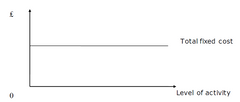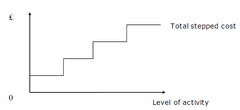![]()
![]()
![]()
Use LEFT and RIGHT arrow keys to navigate between flashcards;
Use UP and DOWN arrow keys to flip the card;
H to show hint;
A reads text to speech;
58 Cards in this Set
- Front
- Back
|
Financial Accounting |
Concerned with classification and recording of monetary transactions. Presentation and interpretation of the results of those transactions. So performance can be assesed over time and the financial position is determined. Based on historical data Used by owners and managers of organisations. Also investors, leaders, debtors, creditors and goverment agencies. Determine sucessfulness of the business. Lots of legal requirments that must be met |
|
|
Managment accounting |
Includes Identifying, measuring, accumulating, analysing, preparing, interpreting and communicating information to managment so that they plan and control the organisation to ensure that resources are being used appropriatly. |
|
|
Role of Managment Accountant |
Applying accounting principles and/or range of costing principles methods and techniques, to ascertain costs. Analysing savings or inefficiencies as compared with previous experiences Operating cost systems as a basis for product profitabiltiy, stock valuation, labour cost analysis, overehad control, and the determination of selling proces. Establishing budgets, standard costs and actual costs of processes, activites or products, and calculating and analysing variances arising. |
|
|
Difference between Financial and Managment accounting |

Financial - Info prepared for external users. Accounts prepared on historical data Financial Accounts - annually Fiancial account must follow the laws Management accounting - Prepared for internal users Use historic data to forecast data Reports prepared when required No Set format |
|
|
Costs are separated into |
Capital and revenue costs |
|
|
Capital Costs |
Costs that have a long term effect on profitability Including aquisitions costs of non-current assets. And costs related with installing this. E.g. Purchases. Extension of Buildings. Purchasing of assets. |
|
|
Revenue Costs |
Short term effect on the profit Benefit is derived from such expanditure for onle one accounting period Purchasing materials, wages, salaries, postage, stationary, rent and rates and insurance |
|
|
Functioncal Costs |
Production costs - costs incurred during the production process. Raw Materials, labour and packaging. |
|
|
Selling Costs
|
AKA Marketing Costs, all costs involved in creating a demand for a product |
|
|
Administration Costs |
General costs for running of a business |
|
|
Finance Costs
|
Costs incurreced in financiang the business - intrest, loans and financial leases. |
|
|
Specialist Costs |
Costs on regular activiteis incured during research and development. |
|
|
Direct Costs |
One that can be directly attributed to a unit of production or a service unit. |
|
|
Indirect Costs |
Costs incurred during the production of a product or the performance of a service, but can't be direclty attibuted to a unit of product or service. Reffred to as overheads. |
|
|
Indirect Cost subdivded futher... |
Direct materials become part of the final product purchased specifically for the products or part or the finished product. Raw Materials costs, delivery costs for raw materials + Material wastage costs. Direct Labour all payments for labour can be directly attributed to a unit of production. |
|
|
Direct Costs and Indirect Costs can be subdived Futher |
Next cards for them all |
|
|
Other direct expenses |
Any cost directly incurred on a specific product. But not direct material / labour.
E.g Costs of designing drawings for a bespoke product |
|
|
Production Overheads |
Unbrella term for a cost during the production process. Not direct o a unit of output E.g Store Staff, rent and rates, depreciation, fuel, repaires, and factory insurnace. |
|
|
Distribution Expenses |
Any expenses in making the product ready for dispatch + delivery. Materials for packaging, warehouse rates, insurance, depreciation of delivery vehicles and delivery drivers wages. |
|
|
Selling (Marketing) overheads |
Costs promoting a product. |
|
|
Admin Overheads
|
Wages + Expenses incurred in running an organisation. Admin Salaries and computer insurance |
|
|
Direct Costs |
Related to a specific unit of production or unit of service. In a Manufacturing organisation might be a batch / one individual unit. Identifying unit of service is however alot more difficult. Could be a mus mile or a hotel room being occupied. |
|
|
Indirect Costs |
Cannot be directly attributed to a cost unit and therfore initially take to a cost cetnre |
|
|
Cost Centre |
Anywhere in which costs are gathered together. Each department will have one. Can be divided into two |
|
|
Service Cost Centre |
Deparments not directyl involved in the day to day manufactuing. But they provide a service to production cost centre |
|
|
Production Cost Centre |
Any departments directly liked to production |
|
|
Processes of allocation and apportionment include |
Allocation of overheads that related to only one cost centre Apportiuoning overheads relating to a number of cost cenctres using a suitable and fair basis Re-apportioning sercie cost centres to production so that all overhead costs are included within one or more production cost centres Unlikely to be question as at level 3 |
|
|
Overhead absorption Rate
|
Total Budgeted cost centre overheads / Budgeted activity |
|
|
Activity is measured usually by either...
|
Direct Labour hours or by Machine hours. Managers of a business will need to determine whether a particular type of cost would be charged to a labour hour overhead rate or a machine hour overhead rate. |
|
|
Labour hour overhead tate costs |
• Production labour idle time • Holiday pay for production workers • Overtime pay for production workers • Supervision costs for production workers • Sick pay for production workers |
|
|
Machine hour overhead tate costs |
• Power for production • Maintenance costs for production machinery • Depreciation of production machinery • Lubricants for production machinery • Computer services for factory machinery • Cleaning materials for factory machinery |
|
|
Overhead absorbtion |
Calculated using estimates of the budgeted level of overhead. Differences occur when actual overheads differ from the budgetted costs. Where this occurs there will either be an under / over absorbtion. |
|
|
Under-Absorbtion |
When overheads absorbed is less than the actual. Budgeted is less than the actual amount of costs. |
|
|
Over-Absorbtion |
When the overheads absorbed is more than the actual. Budgeted is more than teh actual amount of costs. |
|
|
Under Absorbing accounting Journal |
Debit - Overhead Absorbed (IS) - £X - Actual Debit - Under-Absorption (IS) - £X - Difference Credit - Overhead Controll account - £X - Budgetted |
|
|
Over Absorbing accounting Journal |
Debit - Overhead Absorbed (IS) - £X - Actual Credit - Over-Absorption (IS) - £X - Difference Credit - Overhead Controll account - £X - Budgetted |
|
|
Different Cost behaviours |
When activity levels change. Has a big effect on devision making. Must be able to identify behaviour, but also use it to design and create forecasts. |
|
|
Four classifications |
- Fixed Costs - Variable Costs - Semi-variable Costs - Stepped Costs |
|
|
Variable Costs |

Costs vary in direct proportion to activity level. Calc - Variable cost per unit x Number of units. Direct costs might not always be variable as a supplier might always offer bulk purchases discount. Cost per unit will fall when order level qualify for the discount. |
|
|
Fixed Costs |

Costs that do not vary with the level of activity. Rent often used as an example if a company has a warehouse they rent, the cost stays the same reagrless of waht amount of products are produced. Cost may go up if more products are produced that storage. Fixed cost per unit decreases if the level of activity increase. |
|
|
Stepped Costs |

Stepped costs are fixed over a relatively small range of activity and then stepped up to futher costs on new lev el with the certain amount of output.
Production supervisor. Necessary to have 1 for every 10 people. If they increase the people then they must get another supervisor, even if it is for the one extra person. |
|
|
Semi-Variable Costs
|

Costs that contain two elements. - One acts as variable - One acts as a fixed costs |
|
|
High-low Method |
Series of steps. When followed identifies the fixed costs and the variable elements of a cost. Needing two sets of data. |
|
|
High-low Method process |
1. Identifying highest and lowest costs and unit levels. 2. Difference between the two costs 1 3. Difference between the two costs 2 4. Divide difference 1/2 give cost per unit. 5. use variable cost per unit to find the fixed costs 6. Deduct - units x variable cost per unit 7. Check answer by fixed costs on other amounts as same as first one. |
|
|
Production Costs |
Can be calculated on a cost per unit / cost per batch. Cost elements combined in many different ways to fixed product costs. |
|
|
Prime Costs |
Direct costs of production and comprise direct materials, direct labour and direct expenses. |
|
|
Marginal (Variable) Costs |
Cost of proiducing one more unit. Prime Costs + variable production overheads. No fixed overheads. |
|
|
Full Production (Absorption) costs |
Under this method every cost is included in production costs. Including prime costs. Variable Costs + elements of fixed costs. Done by overhead absorption. Total fixed overheads / no of units. |
|
|
Additional Cost classifications... |
As follows... |
|
|
Relevant Costs |
Future cash flow arising as a direct consequence of a decision. They are future, incremental cash flows |
|
|
Avoidable COosts |
Costs which would not be incurred if the activity to which they relate did not exsist |
|
|
Differential Costs |
The difference in total costs between the alternatives |
|
|
Non-relevant costs |
Costs that are irrelevant for decision making because they are not future cash flows, or they will be incurred anyway, regardless of the decision made |
|
|
Sunk Costs |
A cost that has already been incurred and thus should not be taken into account when decision making |
|
|
Committed costs |
A future cash flow that will be incurred anyway, whatever decision is taken now about alternative opporunities |
|
|
Nation or imputed costs |
Hypothetical accounting costs to reflect the use of a benefit for which no actual cash expense is incurred, e.g. national rent charged to a profit centre from the organisation |
|
|
Directly attributable fixed costs |
costs which would increase if certain extra activities were undertaken, or decrease if decision were taken to reduce or shut down operations - relevant to decision making |
|
|
General fixed overheads |
Costs which will be unaffected by decisions to increase or decrease the scale of operations - these are irrelevant to any decision |

